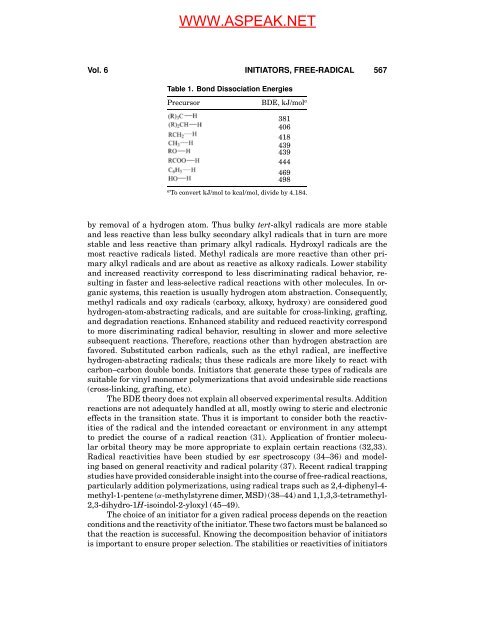"Initiators, Free-Radical". In: Encyclopedia of Polymer Science and ...
"Initiators, Free-Radical". In: Encyclopedia of Polymer Science and ...
"Initiators, Free-Radical". In: Encyclopedia of Polymer Science and ...
You also want an ePaper? Increase the reach of your titles
YUMPU automatically turns print PDFs into web optimized ePapers that Google loves.
WWW.ASPEAK.NET<br />
Vol. 6 INITIATORS, FREE-RADICAL 567<br />
Table 1. Bond Dissociation Energies<br />
Precursor BDE, kJ/mol a<br />
381<br />
406<br />
418<br />
439<br />
439<br />
444<br />
469<br />
498<br />
a To convert kJ/mol to kcal/mol, divide by 4.184.<br />
by removal <strong>of</strong> a hydrogen atom. Thus bulky tert-alkyl radicals are more stable<br />
<strong>and</strong> less reactive than less bulky secondary alkyl radicals that in turn are more<br />
stable <strong>and</strong> less reactive than primary alkyl radicals. Hydroxyl radicals are the<br />
most reactive radicals listed. Methyl radicals are more reactive than other primary<br />
alkyl radicals <strong>and</strong> are about as reactive as alkoxy radicals. Lower stability<br />
<strong>and</strong> increased reactivity correspond to less discriminating radical behavior, resulting<br />
in faster <strong>and</strong> less-selective radical reactions with other molecules. <strong>In</strong> organic<br />
systems, this reaction is usually hydrogen atom abstraction. Consequently,<br />
methyl radicals <strong>and</strong> oxy radicals (carboxy, alkoxy, hydroxy) are considered good<br />
hydrogen-atom-abstracting radicals, <strong>and</strong> are suitable for cross-linking, grafting,<br />
<strong>and</strong> degradation reactions. Enhanced stability <strong>and</strong> reduced reactivity correspond<br />
to more discriminating radical behavior, resulting in slower <strong>and</strong> more selective<br />
subsequent reactions. Therefore, reactions other than hydrogen abstraction are<br />
favored. Substituted carbon radicals, such as the ethyl radical, are ineffective<br />
hydrogen-abstracting radicals; thus these radicals are more likely to react with<br />
carbon–carbon double bonds. <strong><strong>In</strong>itiators</strong> that generate these types <strong>of</strong> radicals are<br />
suitable for vinyl monomer polymerizations that avoid undesirable side reactions<br />
(cross-linking, grafting, etc).<br />
The BDE theory does not explain all observed experimental results. Addition<br />
reactions are not adequately h<strong>and</strong>led at all, mostly owing to steric <strong>and</strong> electronic<br />
effects in the transition state. Thus it is important to consider both the reactivities<br />
<strong>of</strong> the radical <strong>and</strong> the intended coreactant or environment in any attempt<br />
to predict the course <strong>of</strong> a radical reaction (31). Application <strong>of</strong> frontier molecular<br />
orbital theory may be more appropriate to explain certain reactions (32,33).<br />
Radical reactivities have been studied by esr spectroscopy (34–36) <strong>and</strong> modeling<br />
based on general reactivity <strong>and</strong> radical polarity (37). Recent radical trapping<br />
studies have provided considerable insight into the course <strong>of</strong> free-radical reactions,<br />
particularly addition polymerizations, using radical traps such as 2,4-diphenyl-4methyl-1-pentene<br />
(α-methylstyrene dimer, MSD) (38–44) <strong>and</strong> 1,1,3,3-tetramethyl-<br />
2,3-dihydro-1H-isoindol-2-yloxyl (45–49).<br />
The choice <strong>of</strong> an initiator for a given radical process depends on the reaction<br />
conditions <strong>and</strong> the reactivity <strong>of</strong> the initiator. These two factors must be balanced so<br />
that the reaction is successful. Knowing the decomposition behavior <strong>of</strong> initiators<br />
is important to ensure proper selection. The stabilities or reactivities <strong>of</strong> initiators



